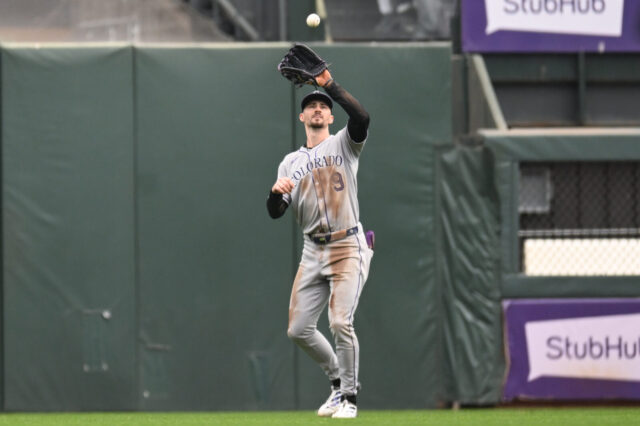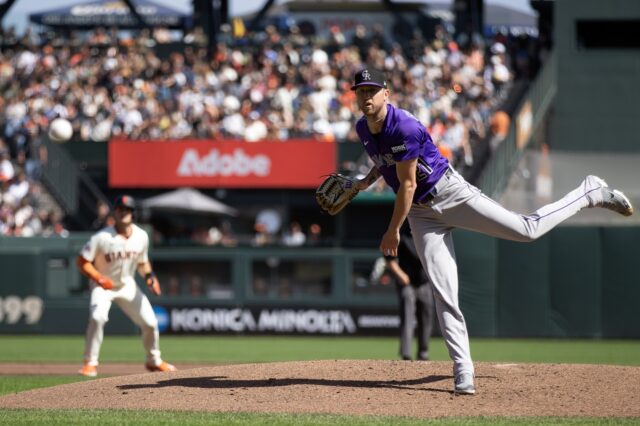Now that the Colorado Rockies have officially introduced new President of Baseball Operations Paul DePodesta, and now that he has made some of his first priorities clear, we can dive back into the on-field strategies that need to be adopted to make this team competitive.
And we must start with the pitching.
As has been the case since the beginning of baseball, nothing impacts the outcome of a ballgame more than that day’s starting pitcher. This remains true despite the advent of modern “bullpenning” and the challenges of Coors Field.
The history of the Rockies reveals that all five (yes, only five) postseason appearances correlate directly with their five best seasons of starting pitching. No such relationship exists for the offense.
So DePodesta was spot-on in his introductory press conference. He focused first and foremost on the philosophy on the mound. In the following days, the last remaining vestiges of the previous pitching regime left the organization, leaving those in the know wondering who will fill the void.
Undoubtedly, one of the architects of Moneyball will (and should) seek out some of the best analytical minds in the business to help solve this most puzzling of puzzles. But it would also be of great benefit to also seek to mine the experience of those who have toed the rubber at a mile high before.
Adam Ottavino got his name into the mix for all manner of potential positions in the Rockies future. Seems only natural that he might help in crafting a coherent plan. Ottavino, after all, is a member of an incredibly rare group of human beings who struggled pitching elsewhere before finding themselves in Denver.
Of course, if you know your history, there is a King of that category… and of Coors Field. His name is Jorge de la Rosa. And if the Rockies aren’t studying his career like the Zapruder Film then they aren’t doing their due diligence.
If de la Rosa has even the slightest interest, he should be employed by the team immediately. But even if not, his body of work should be at the forefront of future understanding. For those unaware, JDLR holds the single most impressive stat in Colorado Rockies history. All apologies to Todd Helton. The Mexican-born southpaw won 73 percent of his games at Coors Field. How? Why?
The Rockies need to learn the answers to those questions. Then they will be well on their way to finally having a solution to their biggest problem. It should quite literally be someone’s job to watch every single pitch he ever threw in a Rockies uniform. Watch the ones he threw at home twice. His film and stats should be their guide. Every pitcher is different, yes. But every pitcher could learn from the man who handled the elements the best.
If he’s so inclined, someone must ask him regularly about his approach, strategy, and mentality. If this new brain trust can figure out a way to clone JDLR’s DNA, that would work too. But that seems less likely. Probably better just to ask the man.
As tempting as it can be to try to find a way to recreate Ubaldo Jimenez, German Marquez, or John Gray, the history of those fireballers shows that they tend to shine bright and burn out fast in the altitude. Guys like de la Rosa and Aaron Cook, on the other hand, are some of the few who managed longevity in MLB’s toughest pitching environment. Neither had overwhelming stuff or high-end pedigree upon their arrival in the Mile High City. They managed to find sustained success largely through persistence and constant adjustments. Both guys should be on the phone if they can’t be in the room.
It is de la Rosa’s dominance at Coors, though, that makes his especially worthy of deep study. Anecdotally (as someone who watched almost every single one of his starts as a Rockie) he would semi-regularly find himself in early trouble. It was common to see him down 3-0, 4-0, even 5-0 after an inning or two pitched in his own ballpark. The game would feel over.
But then, you’d look up in the sixth inning, and it would be a 5-5 game. And, importantly, Jorge de la Rosa would still be on the mound. How much he saved his managers minds and his bullpen’s arms is immeasurable. His ability to win, regardless of the chaos that Coors causes, is measurable, though at 53-20.
To put it simple, de la Rosa was able to compete even if he was getting his ass kicked. And that is going to happen at Coors Field. If they could bottle that ability and let the new guys drink from it, they’d have the magic elixer. Instead, they will need to settle for doing everything they can to figure out exactly how and why JDLR (and Aaron Cook) conquered Coors.



